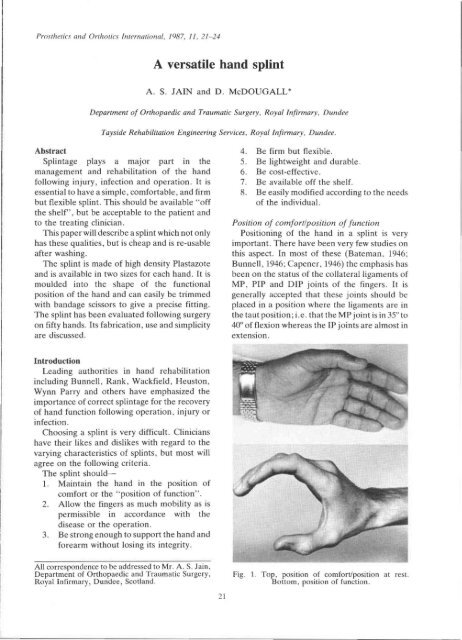View Complete Issue PDF
View Complete Issue PDF
View Complete Issue PDF
Create successful ePaper yourself
Turn your PDF publications into a flip-book with our unique Google optimized e-Paper software.
Prosthetics and Orthotics International, 1987, 11, 21-24<br />
A versatile hand splint<br />
A. S. JAIN and D. McDOUGALL*<br />
Department of Orthopaedic and Traumatic Surgery, Royal Infirmary, Dundee<br />
Tayside Rehabilitation Engineering Services, Roval Infirmary,<br />
Dundee.<br />
Abstract<br />
Splintage plays a major part in the<br />
management and rehabilitation of the hand<br />
following injury, infection and operation. It is<br />
essential to have a simple, comfortable, and firm<br />
but flexible splint. This should be available "off<br />
the shelf, but be acceptable to the patient and<br />
to the treating clinician.<br />
This paper will describe a splint which not only<br />
has these qualities, but is cheap and is re-usable<br />
after washing.<br />
The splint is made of high density Plastazote<br />
and is available in two sizes for each hand. It is<br />
moulded into the shape of the functional<br />
position of the hand and can easily be trimmed<br />
with bandage scissors to give a precise fitting.<br />
The splint has been evaluated following surgery<br />
on fifty hands. Its fabrication, use and simplicity<br />
are discussed.<br />
4. Be firm but flexible.<br />
5. Be lightweight and durable.<br />
6. Be cost-effective.<br />
7. Be available off the shelf.<br />
8. Be easily modified according to the needs<br />
of the individual.<br />
Position of comfort/position of function<br />
Positioning of the hand in a splint is very<br />
important. There have been very few studies on<br />
this aspect. In most of these (Bateman. 1946;<br />
Bunnell, 1946; Capener, 1946) the emphasis has<br />
been on the status of the collateral ligaments of<br />
MP, PIP and DIP joints of the fingers. It is<br />
generally accepted that these joints should be<br />
placed in a position where the ligaments are in<br />
the taut position; i.e. that the MP joint is in 35° to<br />
40° of flexion whereas the IP joints are almost in<br />
extension.<br />
Introduction<br />
Leading authorities in hand rehabilitation<br />
including Bunnell, Rank, Wackfield, Heuston,<br />
Wynn Parry and others have emphasized the<br />
importance of correct splintage for the recovery<br />
of hand function following operation, injury or<br />
infection.<br />
Choosing a splint is very difficult. Clinicians<br />
have their likes and dislikes with regard to the<br />
varying characteristics of splints, but most will<br />
agree on the following criteria.<br />
The splint should—<br />
1. Maintain the hand in the position of<br />
comfort or the "position of function".<br />
2. Allow the fingers as much mobility as is<br />
permissible in accordance with the<br />
disease or the operation.<br />
3. Be strong enough to support the hand and<br />
forearm without losing its integrity.<br />
Fig. 1 Top, position of comfort/position at rest.<br />
Bottom, position of function.<br />
21
















